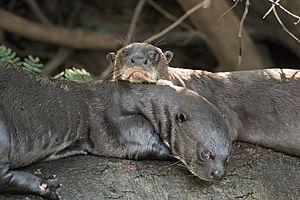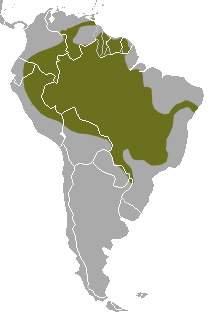Giant otter facts for kids
Quick facts for kids Giant otter |
|
|---|---|
 |
|
| Cuiaba River, Mato Grosso do Sul, Brazil | |
| Conservation status | |
| Scientific classification | |
| Genus: |
Pteronura
|
| Species: |
brasiliensis
|
 |
|
| Giant otter range | |
The giant otter or giant river otter (Pteronura brasiliensis) is a very special type of otter. It is known for being the longest animal in the mustelid family. This family includes animals like weasels, badgers, and other otters.
Giant otters can grow quite long, reaching up to 1.7 metres (5.6 feet) in length. They are also the largest type of otter found anywhere in the world. Unlike some animals, giant otters are diurnal, which means they are active mostly during the daytime. They are also famous for being the noisiest type of otter.
Contents
What Makes Giant Otters Special?
Giant otters are unique in many ways. They are not just big; they are also very social animals.
Size and Appearance
These otters are truly giants! Their long bodies and strong tails help them move easily in the water. They have short, dense fur that keeps them warm and dry. Each giant otter has unique cream-colored markings on its throat. These marks are like fingerprints, helping scientists tell them apart.
Their Noisy Lives
Giant otters are known for being very vocal. They make many different sounds to communicate with each other. These sounds can include barks, hums, and screams. This helps them stay in touch, especially when they are hunting or playing.
Daily Activities
Giant otters are active during the day. They spend their time hunting for food, playing, and resting. They are excellent swimmers and divers. Their strong bodies and webbed feet make them perfect for life in the water.
Where Do Giant Otters Live?
Giant otters live in the freshwater rivers and lakes of South America.
Their Home Environment
They prefer slow-moving rivers and lakes with lots of trees and plants along the banks. These areas provide good places for them to hunt and build their dens. Their dens are often dug into the riverbanks.
Geographic Range
You can find giant otters in many countries in South America. Their range includes parts of Brazil, Bolivia, Colombia, Ecuador, French Guiana, Guyana, Paraguay, Peru, Suriname, and Venezuela. They are especially common in the Amazon and Pantanal regions.
What Do Giant Otters Eat?
Giant otters are skilled hunters. Their diet mainly consists of fish.
Hunting Habits
They use their excellent eyesight and whiskers to find prey in the water. They often hunt in groups, which makes them very successful. Once they catch a fish, they usually eat it right away, holding it in their front paws.
Favorite Foods
Their main food source is fish, including types like piranha. They might also eat small caimans, snakes, and other small animals found near the water.
Giant Otters and Their Families
Giant otters are very social animals. They live in family groups.
Family Life
A typical group includes a breeding pair and their offspring from different years. These groups can have up to 10 or more otters. They work together to hunt, raise their young, and protect their territory. This strong family bond is quite rare among mustelids.
Raising Young
Baby otters are born in dens. They are cared for by the entire family group. The young otters learn how to swim and hunt from their parents and older siblings.
Conservation of Giant Otters
Sadly, giant otters are an endangered species. This means they are at risk of disappearing forever.
Threats to Their Survival
One of the biggest threats is habitat loss. Their homes are being destroyed by deforestation and pollution. Overfishing also reduces their food supply. Hunting for their fur was a big problem in the past, but it is less common now.
What is Being Done?
Many groups are working to protect giant otters. They are setting up protected areas and trying to reduce pollution. Educating people about these amazing animals is also very important. By understanding the threats, we can help ensure giant otters have a future.
Images for kids
See also
 In Spanish: Pteronura brasiliensis para niños
In Spanish: Pteronura brasiliensis para niños











